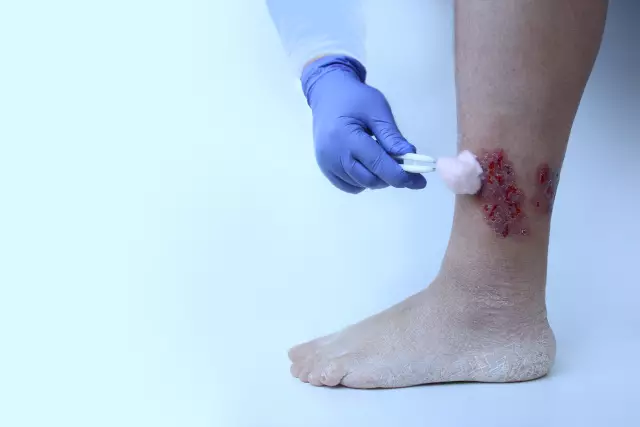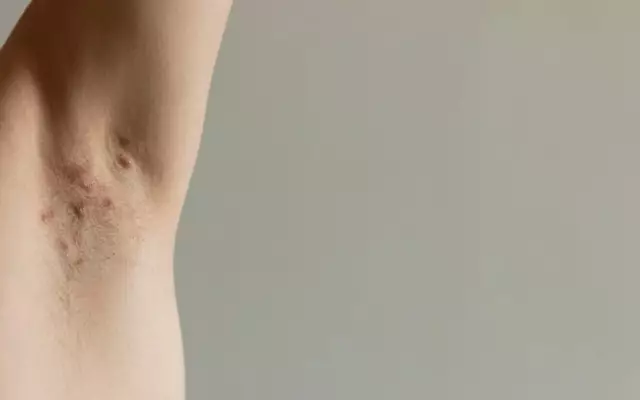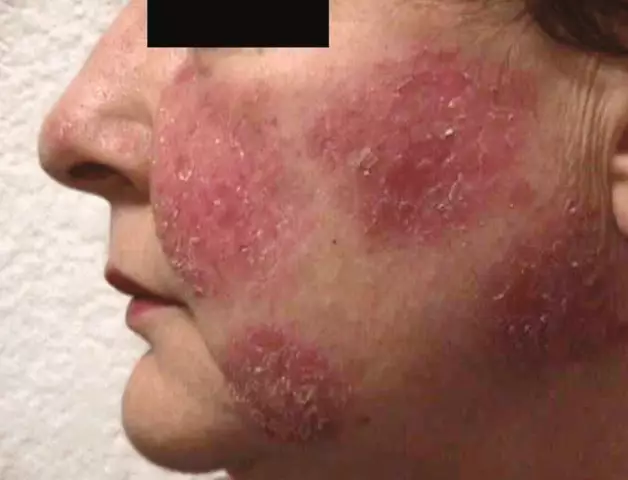- Author Rachel Wainwright [email protected].
- Public 2023-12-15 07:39.
- Last modified 2025-11-02 20:14.
Duodenal ulcer
The content of the article:
- Causes and risk factors
- Forms of duodenal ulcer
- Stages
- Duodenal ulcer symptoms
- Diagnostics of the duodenal ulcer
- Treatment of duodenal ulcer
- Possible complications and consequences of duodenal ulcer
- Forecast
- Prevention of duodenal ulcer
Duodenal ulcer (DU) is a chronic recurrent disease that occurs with periods of remission and exacerbations, characterized by the presence of ulcers (defects that penetrate into the muscle submucosa, scarring during healing) on the duodenal mucosa.

Peptic ulcer is one of the most common diseases of the duodenum
The disease is recorded more often in males, more common among young patients and patients of mature age (up to 50 years). In developed countries, the incidence of duodenal ulcer varies from 4 to 15%. When carrying out fibrogastroduodenoscopy, cicatricial changes, indicating a history of a duodenal ulcer, are recorded in about 20% of patients.
Defects in the initial part of the small intestine are formed much more often than on the gastric mucosa: the ratio of duodenal ulcer and stomach ulcer is 4: 1, according to other data, among young patients for 1 diagnosed gastric ulcer there are 10 identified lesions of the duodenum.
The main danger of duodenal ulcer is associated with the likelihood of bleeding as one of the complications (a number of studies indicate that this condition develops in every fourth carrier of the diagnosis) and with the possibility of perforation of the organ wall with the subsequent development of peritonitis.
Causes and risk factors
The main cause of duodenal ulcer disease (in almost 100% of cases) is infection with the microorganism Helicobacter pylori. The role of these bacteria in the development of inflammatory changes in the mucous membrane of the stomach and small intestine was identified in 1981 by Barry Marshall and Robin Warren, and in 2005 they were awarded the Nobel Prize for their discovery. Helicobacteria are not only the main provocateurs of gastritis and peptic ulcer disease, but are also considered representatives of class I carcinogens.
Helicobacter pylori is a rod-shaped, S-shaped, curved microorganism equipped with several (from 2 to 6) flagella at one of the poles. Moving quickly inside the gastrointestinal tract, it penetrates into the mucus covering the intestinal wall, thanks to the flagella, it corkscrews it penetrates the intestinal wall, colonizes and damages it, causing duodenal ulcer. The optimal conditions for the existence of Helicobacter pylori are the ambient temperature from 37 to 42 ° С and the acidity level of 4-6 pH, which explains the vulnerability of the initial sections of the small intestine, where the pH varies from 5.6 to 7.9.

Most often, duodenal ulcer is caused by the bacterium Helicobacter pylori
The source of infection is a sick person or a carrier of bacteria - a person in whose body the bacteria are located without provoking symptoms of duodenal ulcer. Infection occurs through the fecal-oral or oral-oral route (Helicobacter pylori is secreted in saliva, plaque, feces) through direct contact, the use of contaminated products, the use of cutlery, toothbrushes, seeded with Helicobacter pylori, etc.
Despite the fact that infection with Helicobacter pylori is the main cause of duodenal ulcer, there are a number of other factors that can provoke the disease:
- acute and chronic psychoemotional overstrain;
- alcohol abuse, smoking;
- alimentary factor (systematic consumption of rough, spicy, excessively hot or cold food provokes gastric secretion, excess production of hydrochloric acid);
- taking gastrotropic drugs that have a damaging effect on the inner lining of the organ (non-steroidal anti-inflammatory drugs, salicylic acid derivatives, glucocorticosteroid hormones);
- chronic diseases of the digestive tract (cirrhosis, chronic pancreatitis);
- pressure on the mucous membrane of volumetric neoplasms localized in the submucosa;
- acute hypoxia (trauma, massive burns, coma);
- extensive surgical interventions (the production of hydrochloric acid, one of the factors of aggression, increases up to 4 times within 10 days after the operation);
- severe diabetic ketoacidosis;
- occupational hazards (salts of heavy metals, pesticides, vapors of paints and varnishes, aromatic hydrocarbons).
Risk factors for the development of duodenal ulcer:
- hereditary predisposition (family history is aggravated in about 3-4 people out of 10 with this disease);
- the presence of the I blood group increases the risk of the formation of a peptic ulcer on the duodenal mucosa by almost 40%;
- stable high concentration of hydrogen chloride (HCl) in gastric juice;
- identification of histocompatibility antigens (Human Leukocyte Antigens) B 15, B 5, B 35;
- congenital deficiency of gastroprotectors;
- diseases of the respiratory and cardiovascular systems, in which there is a decrease in the effectiveness of external respiration (chronic obstructive bronchitis, bronchial asthma, heart failure, etc.), while generalized oxygen starvation develops, including the mucous membrane of the duodenum, entailing oppression of local protective factors; and etc.
The pathogenesis of duodenal ulcer is an imbalance between aggressive influences (infection with Helicobacteria, excessive production of HCl and aggressive digestive enzymes, impaired intestinal motility, autoimmune aggression, disruption of the functioning of the parasympathetic link of the ANS and sympatadrenal system, etc.) and protection (mucous barrier), active regeneration of the intestinal epithelium, fully functioning local microvasculature, production of prostaglandins, enkephalins, etc.).
Forms of duodenal ulcer
According to the location of the ulcer:
- bulbar, or bulbous (front wall, back wall, "mirrored");
- post- or retrobulbar (proximal or distal), found in no more than 3% of cases.
Depending on the phase of the inflammatory process:
- aggravation;
- fading exacerbation;
- remission;
- recurrence of duodenal ulcer.
In terms of severity, the disease is classified as follows:
- for the first time revealed UB DPC;
- latent course (asymptomatic);
- mild severity - the disease worsens no more than 1 time in 1-3 years, responds well to conservative therapy, exacerbations last up to 1 week;
- moderate severity - 2 exacerbations during the year, during which patients are hospitalized, it takes up to 2 weeks to stop the symptoms of exacerbation, complications often develop;
- severe form - continuously recurrent, exacerbations are noted more often than twice a year, patients during exacerbations are subject to inpatient treatment, this form is characterized by complications, severe digestive disorders, intense, persistent pain syndrome.
Depending on the size and depth of the ulcer (based on the results of EGD):
- small defect - no more than 5 mm in diameter;
- large ulcer - more than 7 mm;
- giant ulcerative defect - more than 15-20 mm;
- superficial ulcer - depth not more than 5 mm;
- deep ulcer - the depth exceeds 5 mm.
In accordance with the type of intestinal motility disorder, duodenal ulcer can proceed in a hyper- or hypokinetic type.
Morphological types of ulcer defect (ulcer):
- fresh defect;
- migratory ulcer;
- chronic ulcer (in the absence of signs of scarring for more than 1 month);
- scarring ulcer;
- callous ulcer (long-term non-healing, formed by scar tissue);
- complicated ulcer.
Stages
The stages of duodenal ulcer are determined on the basis of the endoscopic picture:
- Fresh ulcerative defect (an increase in inflammation).
- The maximum severity of symptoms.
- Reducing signs of inflammation.
- Regression of the ulcer.
- Epithelialization.
- Scarring (phases of red and white scar).
An alternative classification suggests distinguishing 3 stages:
- Acute inflammatory, with fresh ulcerative damage to the mucosa.
- Stage of incipient epithelialization.
- Healing stage.
Duodenal ulcer symptoms
Symptoms of the disease consist of 2 main syndromes: dyspeptic (digestive disorders) and pain.
Manifestations of pain syndrome leading in the clinic of the disease:
- pain in the projection of the stomach or to the right of the midline (pain may spread to the back, right hypochondrium);
- late (1.5-2 hours after eating), hungry (after 6-7 hours) or night pains (the appearance of early pains half an hour or an hour after eating is uncommon for duodenal ulcer);
- the nature of the pain varies widely (from weak aching to intense boring, cutting, cramping), depends on individual factors;
- pain is relieved by eating or antacids, disappears after vomiting;
- pain is not permanent, occurs periodically (during an exacerbation, more often in the spring-autumn period) lasts from several days to several weeks.

Duodenal ulcer disease is manifested by pain in the stomach or to the right of the midline
Dyspeptic symptoms of duodenal ulcer:
- sour belching, heartburn;
- nausea (with localization of the ulcer in the initial section of the small intestine, it is almost never noted);
- vomiting, bringing relief;
- possibly increased appetite;
- tendency to constipation.
In addition to digestive disorders and pain syndrome, patients may be disturbed by astheno-vegetative symptoms: weakness, lethargy, decreased performance, irritability, and fatigue.
Diagnostics of the duodenal ulcer
To confirm the diagnosis, a number of laboratory and instrumental research methods are used:
- general blood test (signs of anemia in the presence of latent bleeding, leukocytosis, a tendency to an increase in the number of red blood cells and hemoglobin, a decrease in ESR);
- analysis of feces for occult blood;
- cytological and histological examination of a biopsy specimen of the gastric mucosa;
- polymerase chain reaction for detecting fragments of Helicobacter pylori DNA;
- FEGDS with targeted biopsy;
- X-ray of the stomach with double contrast (ulcerative niche, a symptom of a pointing finger on the opposite wall, bowel deformity, delay of contrast agent at the site of the ulcer, etc.).
Treatment of duodenal ulcer
Treatment of duodenal ulcer disease, as a rule, is conservative, is implemented in two main directions: eradication of Helicobacter pylori and normalization of the functioning of the small intestine, restoration of the balance of defense and aggression factors, healing therapy.
Eradication therapy is carried out using three- or four-component regimens [proton pump inhibitors or H2-histamine blockers, gastroprotectors, antibacterial drugs (macrolides, semi-synthetic penicillins, or antimicrobial drugs)].
In order to relieve symptoms and stimulate the healing of defects in erosive gastritis, drugs of the following groups are used:
- antacids and adsorbents;
- reparants;
- antioxidant drugs;
- prokinetics;
- antispasmodics;
- sedatives.
In addition to drug treatment, a prerequisite for a speedy recovery is a change in lifestyle (rational diet, quitting smoking, alcohol abuse, etc.), adherence to the principles of mechanical (boiled food or steamed, not injuring the inflamed surface of the mucous membrane), chemical (elimination of aggressive carbonated, sour, spicy, overly salty foods) and thermal (warm food, exclusion of hot or cold dishes) food sparing.

Treatment of duodenal ulcer disease is predominantly conservative
With the ineffectiveness of conservative therapy, as well as in the case of complications, surgical excision of the ulcer is recommended.
Possible complications and consequences of duodenal ulcer
Duodenal ulcer disease can have the following complications:
- bleeding;
- perforation (perforation of the intestinal wall);
- penetration (germination into the nearby organs of the digestive tract);
- malignancy (malignancy);
- stenosis of the initial part of the small intestine.
Forecast
Recurrence of the disease is noted in more than half of the cases in the first year after scarring of the ulcer, and within 2-3 years after the onset of the disease - in 8-9 out of 10 patients. With complex treatment, the prognosis is favorable, worsens with continuous recurrence, systematic development of complications.
Prevention of duodenal ulcer
- Compliance with personal hygiene measures in order to prevent infection with Helicobacter pylori.
- Rational diet.
- Refusal to use products that irritate the mucous membrane of the digestive tract.
- Timely treatment of chronic diseases that can provoke the development of duodenal ulcer.
YouTube video related to the article:

Olesya Smolnyakova Therapy, clinical pharmacology and pharmacotherapy About the author
Education: higher, 2004 (GOU VPO "Kursk State Medical University"), specialty "General Medicine", qualification "Doctor". 2008-2012 - Postgraduate student of the Department of Clinical Pharmacology, KSMU, Candidate of Medical Sciences (2013, specialty "Pharmacology, Clinical Pharmacology"). 2014-2015 - professional retraining, specialty "Management in education", FSBEI HPE "KSU".
The information is generalized and provided for informational purposes only. At the first sign of illness, see your doctor. Self-medication is hazardous to health!






